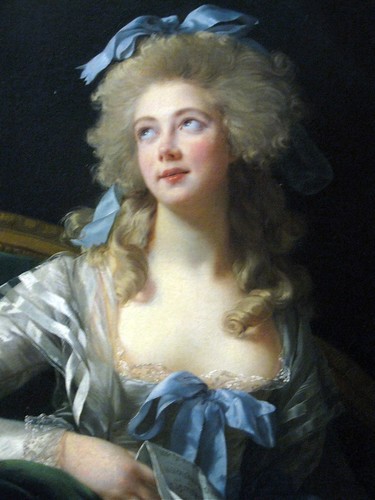Character Development on a "Grand" Scale

A recent Facebook exchange about character development with our own Tracy Grant inspired me to share our musings with you. The subject began with Talleyrand and quickly morphed into a brief discussion of the painting titled "Madame Grand" that hangs in the European collection of New York City's Metropolitan Museum. Painted in 1783 by one of the era's few female portraitists, Elisabeth Vigée LeBrun.
Catherine Noelle Worlee was born in India in 1762 to a French official stationed in Pondicherry. And it was in India in 1778 where the (barely) sixteen-year-old Catherine wed George Francis Grand, a British civil servant who could boast of Huguenot (French Protestant) roots.
Catherine was evidently quite the hoyden (I found a reference to her numerous "amorous adventures") both in London and Calcutta, leading me to suspect that she was perhaps the distaff version of an 18th-century rake. In fact, her affair with Sir Philip Francis, the deputy to India's Governor-General Warren Hastings, created quite the colonial scandal, resulting in her marital separation.
This portrait, where Madame Grand rolls her eyes heavenward as if she is so over something (her husband? her life? her social circle?) fascinates me no end.
Let's imagine that I did no research on her actual backstory, but merely found her an interesting subject for a novel, as either a leading or supporting character. I am intrigued by her facial expression, rare for any subject, as it's neither placid nor particularly pretty. It's so deeply personal that I want to know more about her -- and even invent it, guessing what lies behind her oh-I-am-so-over-it mood. Was she unhappily married to Grand? Something must have been going on, because she was awarded a divorce, also rare for the era. Was it her own infidelity that sparked the split? Or Grand's?
In 1802 she wed again, this time to her longtime lover, the powerful French diplomat, Charles Maurice Talleyrand, one year her junior, becoming Madame Talleyrand-Perigord, Princesse de Bénévent. It was Napoleon who forced his friend's hand and demanded that Talleyrand make an honest woman of Catherine. But this match was not much more successful than Catherine's first marriage. The couple drifted apart, although Talleyrand provided his estranged wife with enough to retain her luxurious London lifestyle. Catherine died in Paris in December 1834 at the age of seventy-two.

Talleyrand; painted by Pierre-Paul Prud'hon
The portrait of "Madame Grand" immediately struck me as a terrific character study from either end of the equation, either as someone I might like to portray in historical fiction, or merely as the image of a woman who might epitomize one of my fictional characters.
Authors: do you ever come across portraits (or photos) and think "that's my character!" and incorporate that into your writing? During your research stage, do you ever look for a painting that might encapsulate the image of your creation?
Readers: do you "cast" a novel you're reading with images you've seen on canvas (or on film, for that matter)?
For everyone: how does having a "visual" for a character aid in understanding him/her better?



Comments
Post a Comment